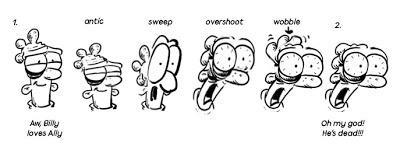The principles reflect Frank Thomas' and Ollie Johnston's desire to make the way Disney animations moved and express character and emotions look more real.
12 Principles of animation:
1. Squash and Stretch - allows an animator to create the illusion of weight and volume of an object. How extreme the squash and stretch is dependent on what you are animating.
2. Anticipation - communicates what is going to happen. Put anticipation within the movement of a character or object before a major action.
3. Staging - the presentation of an idea clearly communicated to the audience. Communicates the attitude or emotional state of a character or object within a story. Directs attention to the ideas or story being told.
4. Straight Ahead and Pose to Pose Animation - different ways of animating which can give different results. Straight Ahead animation is animating frame after frame without using keyframing. If not careful can end up losing the sense of scale, size and volume. Pose to Pose animation is carefully planned and the animator works out what key poses will be needed to make an animation work. 'in between' frames are done by an assistant. Allows animator to focus on the key poses allowing control over the movement and performance of the animation.
5. Follow Through and Overlapping Action - happens when the body of an object or character has stopped moving. With Follow Through nothing stops all at once such as long hair, a tail, loose clothes, etc.
Overlapping Action is when an object or character changes direction and their clothes, hair, etc. continue forward. This gives the sense of looseness.
6. Slow-Out and Slow-In - an action which starts with more drawings at the beginning at the start of the pose, few in the middle and more drawings near the end. Fewer drawings create faster actions, more drawings create slower actions.
7. Arcs - actions, except some mechanical ones, follow an arc or circular path. Human figure and animals tend to follow arcs. They make animations flow making them feel more natural.
8. Secondary Action - supports and reinforces the intentions of the first. Gives more meaning.
9. Timing - requires you to try again, refine and try again. Practice makes perfect. Mixture of slow and fast timing adds texture and interest to the movement. Think about the timing of the character performing to establish things like mood, emotions and reactions to a person or situation. For the best possible animation you need to study life (e.g. actors, performers, animals).
11. Solid Drawing - basic principles of drawing form, weight, volume solidity and the illusion of 3D apply to animation. Creating the illusion of life within a character or object.
12. Appeal or character Personality - appeal creates an emotional connection between character and audience. A well developed character with an interesting personality and a clear set of desires or needs that drives his/her behaviour and actions. Character must have a pleasing design, have a certain charm, magnetism and be able to communicate it well. Same with villains otherwise there will be no interest in what they are doing.










No comments:
Post a Comment